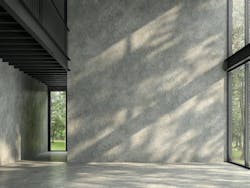Concrete is an excellent thermal conductor, which is another way of saying it’s a poor insulator. Heat flows from hot to cold, so in winter, concrete pulls heat out of the house, making the heating system work harder (and making a slab-on-grade floor uncomfortably cold). In summer, the concrete pulls heat in and radiates it into the room, making the HVAC system work harder.
This heat transfer occurs faster the larger the difference is between inside and outside temperatures. For example, heat will flow through concrete more quickly in cold-climate winters when the difference between outside and inside temperatures may be 70 degrees or more (0O F outside, say, and 70O F inside). The summer differential is smaller, so heat transfers more slowly.
Perimeter problem
Putting insulation under slabs may be required for some energy certifications, but in typical homes, the temperature differential is pretty small. It’s better to spend money here only after you’ve significantly improved air sealing, attic and wall insulation (R-100 and R-40 respectively), and boosted the windows to triple-glazed R-5 units.
That said, combatting heat flow through a slab boils down to putting insulation over the biggest energy leaks, and one big cold spot on a slab-on-grade house is where the edge of the slab is left exposed to the outdoors. It’s a big source of heat loss in warm climates (zones 1, 2, and 3), and creates an even bigger thermal leak in cold climates (zones 4, 5, and 6) because the temperature differential is much larger than in hot climates.
Perimeter problem
Blocking the exposed perimeter eliminates most of the heat loss, keeping the monolithic slab warm and dry all the time. It’s no surprise, then, that insulating the edges of slabs is one of the items on the Energy Star checklist. The details shown here are not high-performance details because the underside of the footings and slab are still thermal bridges to the ground. But the sides of the slab are covered, and that’s where most heat loss occurs, so these details will be a big improvement for most homes.
The details shown here assume that the monolithic slab has been placed over a layer of poly over a layer of stone to act as a capillary break. (Otherwise you may have to treat the top of the slab to prevent moisture from wicking in (see “Building Things Right: Finished Basement”).
You can use any insulation rated for below-grade use, but most builders and remodelers favor extruded polystyrene (XPS). In areas with a lot of termites, you will need to take extra precautions, including borate-treated foam, termite shields, and inspection gaps.
With the exception of the first step, the details are similar for both hot and cold climates, including the depth at the perimeter, which doesn’t need to be dug below the frost line in cold climates; depending where you live, 12, 14, or 16 inches deep is deep enough.
See step-by-step instructions here
About the Author
Daniel Morrison
Editorial Director
Daniel Morrison is the editorial director of ProTradeCraft, Professional Remodeler, and Construction Pro Academy.

